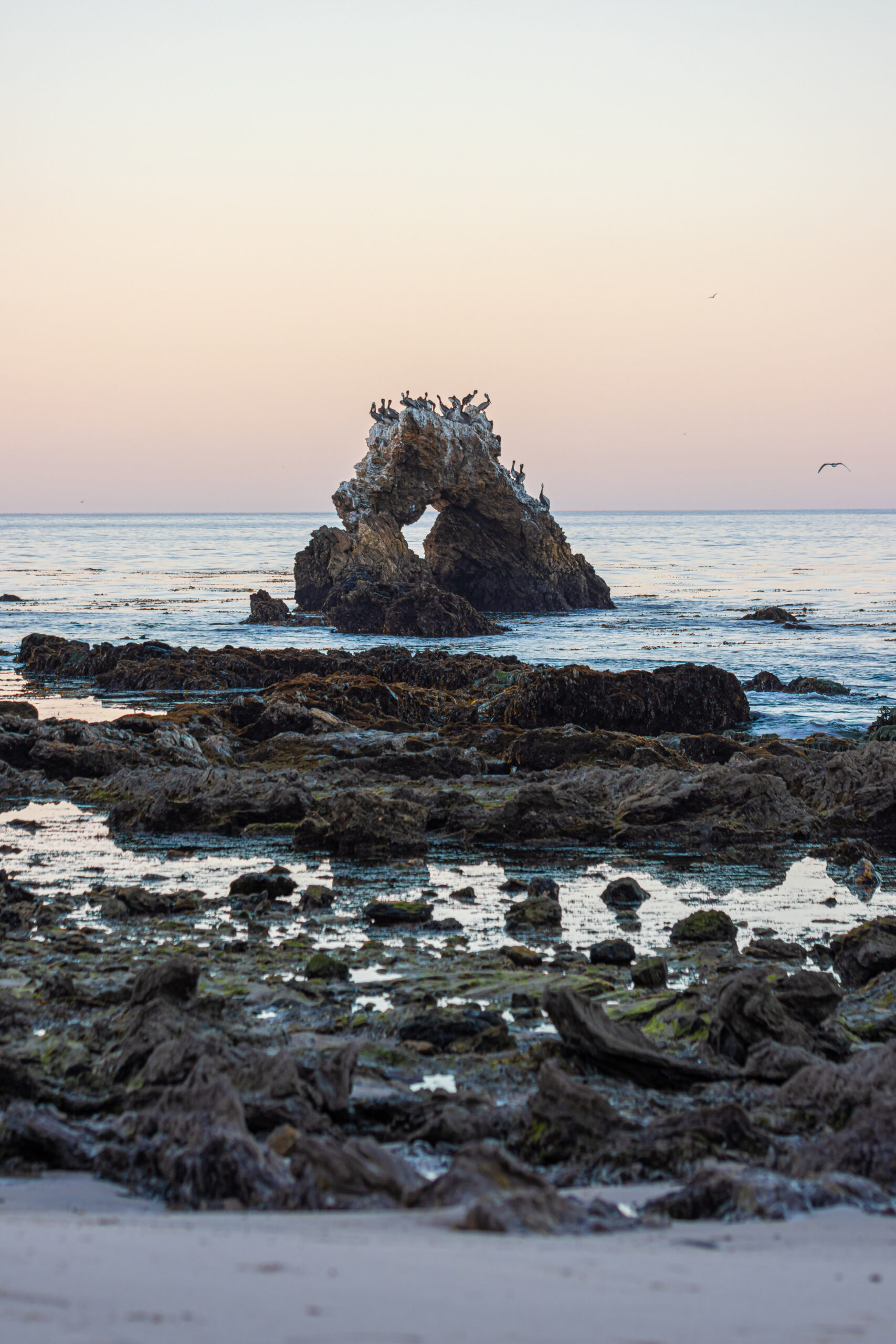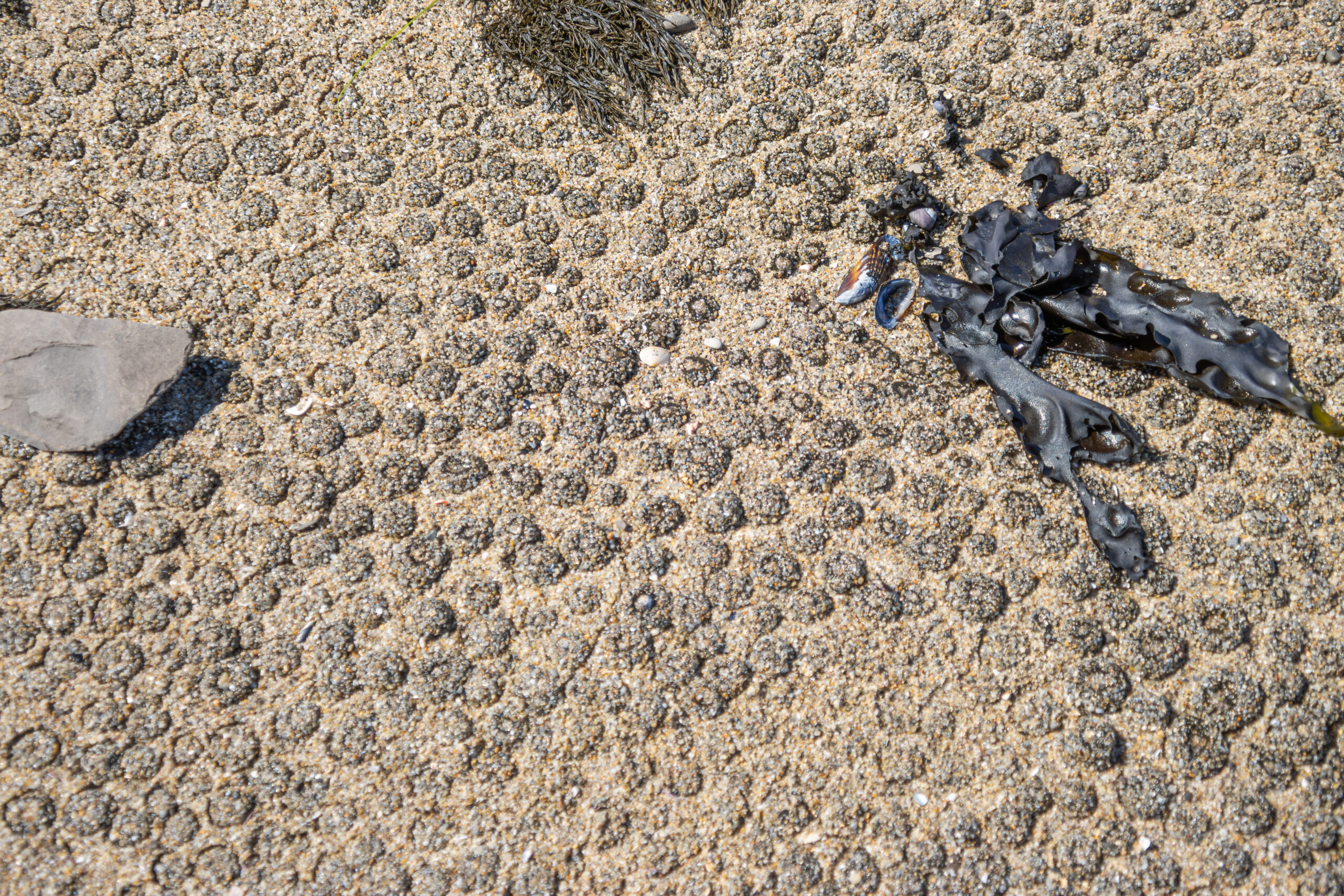
Traversing Tidepools: Gateway to Intertidal Species
What are Tidepools?

When we take toward the retreating tides, marine mysteries are revealed. We can explore a landscape typically covered by the ocean… and the species that wonder amongst the rocky crevices.
If you are fortunate enough to live near the coast, you have a unique opportunity to explore habitats that are said to have diversity of lifeforms rivaling that of rainforests.
Tidepools are located along the rocky coast, where the ocean meets the land. They are the pockets of water exposed during low-tide that capture many marine invertebrates such as sea stars, crustaceans, sea slugs, anemones, and sometimes even octopodes.
Tidal Zones
Intertidal zones are influenced by the tidal activity that changes throughout the day. The earth’s rotation and gravitational forces of the earth, moon, and sun are all factors that play a role in shifting the tides to and from land.

When speaking about tidal zones, there are typically five zones depicted: the splash zone, high tide zone mid tide zone, low tide zone, and subtidal zone. Each zone is categorized by their depth and patterns of exposure. Indicator species found within the tidal zones are useful for telling us the zone we are observing.
Splash Zone
The splash zone is never submerged under water, but it can be exposed to ocean spray and crashing waves. You can find periwinkle, limpets, and rock louse in this tide zone.
High Tide Zone
The high tide zone is under water during high tide, but exposed as the tide retreats towards the ocean. Organisms in this zone have evolved adaptations to the constantly changing environmental conditions throughout the day. Organisms such as barnacles, turban snails, periwinkle, crabs, and rockweed can be found in high tide zones.
Mid Tide Zone
The mid tide zone experiences large amounts of wave action, known as “wave shock”. Many of the organisms in this tidal zone have adaptations that help them remain stuck to surfaces. This zone is known to have mussels, barnacles, limpets, chitons, sea stars, crabs, and anemones.
Low Tide Zone
The low tide zone is only revealed for a few hours each month. The organisms in this zone are highly vulnerable when they are exposed. They are prone to overheating and drying out. Organisms found within this zone are limpets, sea urchins, sea sponges, and sea stars.
Subtidal Zone
The subtidal zone is typically submerged under water, but there are rare instances throughout the year where these areas are exposed. The organisms in this zone are adapted to life under water. Organisms found within this zone are sea urchins, sea hares, octopodes, nudibranchs, sculpins, sea cucumbers, tubeworms, and many species of algae.
Intertidal Communities









Tidepools house communities of diverse organisms. Above are some of the intertidal invertebrates that I have found while tidepooling over the years. From top-left to bottom-right are the Striped Shore Crab with Copepods, Giant Green Anemone, Purple Shore Crab, File Limpet with Shield Limpet, California Spiny Chiton, California Mussel with Gooseneck Barnacle, Ochre Sea Star, California Sea Hare, and Bat Star.
Prior to my studies, I had no idea what some of these organisms could be classified as. It was difficult for me to comprehend the fact that each of these organisms was a species of animal. It was simple enough to understand that crabs were animals, but sea anemones do not come to mind when I envision animals. This is part of why I find tidepools so fascinating.
Tidepools reveal to us a glimpse into some of the wonders that could be found beneath the waves. The ocean can feel so foreign and mysterious. Exploring tidepools offers an easy starting point to unravel the lifeforms of the ocean that feel very alien.
Like any other ecosystem, tidepools house communities of organisms that interact with each other through competition for resources such as food and space. Many invertebrates eat the algae that grows on the rocky shores.

California Mussels will filter-feed, eating microscopic plankton and algae in the water. These same mussels will compete with Gooseneck Barnacles for food and access rocky surfaces they can attach to. Ochre Sea Stars – the top predator of the tidepool ecosystems will thrive by prying open the shells of mussels, inverting their stomach, engulfing the mussel into their stomach, and absorbing the nutrients into their system. There is a dense and diverse food web that occurs in such a small space. If this doesn’t fascinate you, I don’t know what will!
Tidepooling: The Basics
The following are going to be a series of recommendations for getting started with tidepooling. It is important to have fun while tidepooling, but preparation, safety, and stewardship are paramount and must be at the forefront of your mind when participating in this activity.
Preparation
Checking Tide Tables
Before you go to the intertidal zone, you need to check tide tables relevant to the area you plan on visiting. Along most coastlines, there are two high tides and two low tides per day. You will want to time your visit to align with one of the low tides. You will also want to take into account how intense the low tide is. The more intense the low tide is, the more tidepools you will be able to explore.
NOAA Tide Predictions
If you visit the National Oceanic and Atmospheric Administration’s Tide Predictions website, you can determine when the low tides are on a given day as well as their intensity, if you are located in the United States.

Tide Forecast
A different website that you could use to check the tide predictions is Tide Forecast. This website provides predictions for tides across the world, so it can be used for coasts outside of the United States.


What to Bring
- Shoes with good traction that you won’t mind getting wet. There is a lot of slippery algae.
- Extra socks. It is very easy for your feet to slip and land into a deep pocket of water.
- Towel. You will likely want it in case you get splashed or slip into the water.
- Sunscreen. It is always nice to protect your skin from UV rays.
- Small first aid kit. You can easily scrape or cut your skin on the rocks if you aren’t careful.
- Pocket guide. Pamphlets like the California Seashore Life Guide are useful for identifying species.
- Camera. Preserve your memories and findings through photos!
- Watch. This will help you keep track of the time to know when the tide is rising.
Safety
If you aren’t careful while exploring the intertidal zone, things can become potentially dangerous. These are some hazards that you will want to bear in mind, while tidepooling.

Slipping Hazard
Ensure you are careful while walking along rocky terrain. It is easy to slip and fall in the intertidal zone because of the algae covering much of the rocky surface. Slipping and falling onto jagged rocks is something you will want to avoid.
Rising Tides
Keep track of when the tide starts to rise. If you don’t know how to swim (like me), things can get especially dangerous if you aren’t paying attention. Sometimes when exploring the intertidal zone, there are dips that are above water during low tide, but as the tide rises, they become submerged under water.
Splash Hazard
Try not to get too close to the ocean edge of the intertidal zone and try to face towards the ocean. Unexpected waves can crash into you, knocking you down onto the rocks. This can cause injury.
Stewardship
As visitors to a unique and delicate location that houses immense amounts of biodiversity, we will want to limit our footprint as much as possible. These fragile ecosystems can be easily damaged if we aren’t responsible environmental stewards.

Tidepool Trampling
When walking across the intertidal zone, watch your step! Many of the animals that live on the intertidal zone are adapted to harsh and everchanging changing conditions, but this doesn’t mean that stepping on them won’t injure or kill them. Many species are attached to and cover large surfaces. They may even blend into their surroundings very well, like Aggregate Anemones exposed to air. Limit your footprint by walking along paths that have limited or no organisms covering them.
Tidepool Poaching
When tidepooling, you can find many beautiful and unique animals. You may even find some beautiful shells, oysters, or sea stars. As tempting as it may be to take them home, don’t. Aside from being illegal, tidepool poaching can have drastic effects on intertidal ecosystems. The beautiful shell you found may have been necessary for a hermit crab to survive. The vibrant sea star is at the top of intertidal food chains, keeping populations in check.
Conclusion

Tidepooling is a worthwhile endeavor if you are interested in learning more about life on the tides. It offers you a glimpse into the seemingly alien life forms that exist in the ocean. Although much planning should go into a tidepooling trip, I feel the experience is worth it. Hopefully this post has prepared you to take to the tides and traverse tidepools! If you have any questions or concerns, feel free to leave a comment down below!
You may also like
Archives
Calendar
| M | T | W | T | F | S | S |
|---|---|---|---|---|---|---|
| 1 | 2 | 3 | 4 | 5 | 6 | |
| 7 | 8 | 9 | 10 | 11 | 12 | 13 |
| 14 | 15 | 16 | 17 | 18 | 19 | 20 |
| 21 | 22 | 23 | 24 | 25 | 26 | 27 |
| 28 | 29 | 30 | ||||

